More Odds & Ends: Guilds of Ravnica
Last week, I started answering your questions about Guilds of Ravnica. This week, I continue because you all asked so many interesting things.
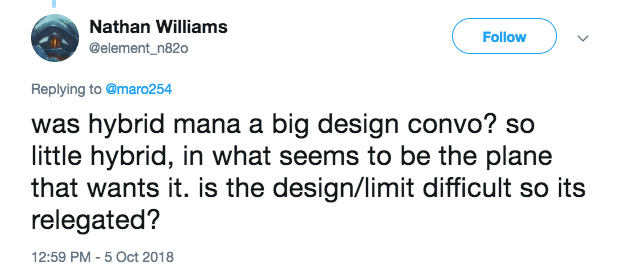
Hybrid is at the exact same level it's always been in a Ravnica set—it's in a vertical cycle, meaning one card at common, one card at uncommon, and one card at rare. Let's take Dimir as an example.
Ravnica: City of Guilds
- Common – Lurking Informant
- Uncommon – Dimir Guildmage
- Rare – Shadow of Doubt
Gatecrash
- Common – Deathcult Rogue
- Uncommon – Coerced Confession
- Rare – Nightveil Specter
Guilds of Ravnica
- Common – Whisper Agent
- Uncommon – Discovery (of Discovery // Dispersal)
- Rare – Connive (of Connive // Concoct)
Guilds of Ravnica is unique in that two of its hybrid cards are parts of split cards, but the total number of hybrid cards is exactly the same as the previous two visits to Ravnica.
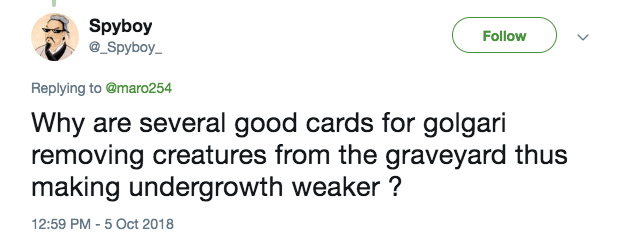
The Golgari is a guild about using the graveyard. There are a few different ways to do that. One is to use it as a barometer where cards merely look at the graveyard and get strength from certain cards being there. That's what undergrowth is doing.
A second is having cards that have a utility while in the graveyard. Sometimes they get to stay in the graveyard, but usually using them means removing them from the graveyard. In Guilds of Ravnica, Izzet is playing in this space with jump-start.
A third way is to use the graveyard as a resource. This is where you "eat" cards out of your graveyard (usually exiling them) as a means to fuel an effect. Charnel Troll is an example of this.
A fourth way is cards that help you get cards into your graveyard. Charnel Troll is also an example of this.
A fifth way is by allowing you to manipulate cards in the graveyard, often moving them to other zones like the hand or battlefield. Golgari Findbroker is an example of this.
To make Golgari a deep and layered guild, we like to play around with all of these (save the second, which we used in Izzet this time around). That means that there will be times where various cards create tension with one another. Too much tension is bad, but a little tension allows players to make interesting decisions and ensures that games play out a little differently. That's why undergrowth coexists with cards that "eat" cards out of the graveyard.

This is due to a number of factors. One, our takeaway from Ixalan was that complexity (especially at common) was too low, so we've been experimenting with different complexity levels. Two, we've learned over the years that a tight structure helps guide newer players with deck building and can allow us to increase the complexity a little. For example, Ravnica sets strongly encourage players to play two colors (and a specific set of two-color combinations at that), which can help cut down on players freezing up when building a deck.
Three, we're always experimenting with new lenticular design space (aka things where the card appears simpler to a less experienced player that can't see all the ways the card could be used in play). Four, now that sets are only drafted by themselves, we have a little of the extra complexity that we saved for when the whole block was played together that we can tap into. So, add all these various factors together, and Guilds of Ravnica gets to be a little more complex than our average set has been, although not less complex than some full blocks of the not-so-distant past (things like the Amonkhet/Hour of Devastation environment).

Return sets are easier to design in some ways and harder in others. On the easy side, it comes with a built-in structure. One of the hardest parts of making a new world is figuring out what that world is about mechanically, what's the core of the gameplay? Return worlds have already figured that out. Ravnica, for example, is a multicolor environment built around the ten two-color factions, chopped up between multiple sets. Return worlds also come with a lot of data. We've made cards, seen the players play with them, and had a chance to look at the market research about those cards. We know what players like and don't like, and we can use that knowledge to make sure the return leans into what's popular and away from things that aren't.
On the hard side, returns come with a lot of expectations. We want every new set to come with new mechanical exploration, and that gets harder when the audience expects so many different elements to return. Carving out new space requires figuring out what not to bring back and, on a popular world, that gets difficult. Added to that, the new material has to feel organic to the stuff that's already there. For example, we built the new guild mechanics assuming the players are going to mix the guild cards from all three visits together. This requires us trying to find variations within known design spaces and that can be very tricky, especially as some guilds are narrower than others in scope.
All that said, it was trickier for some guilds than others. Dimir and Golgari have always historically proven difficult. Selesnya and Boros, in contrast, have not. Izzet has its own problem in that its philosophical space doesn't overlap as well with its mechanical space as the other nine guilds. So, all in all, there were some challenges, but I'd say Guilds of Ravnica was less challenging overall than some other sets we've made over the last five years. I think a lot of this is owed to all the hard work done on the last two Ravnica blocks that have provided this world with so many powerful and effective design tools.
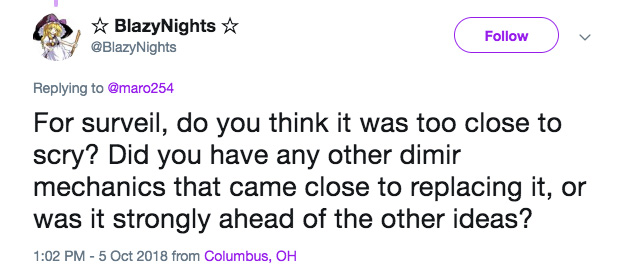
One of the ongoing issues with designing a 25-year-old game is figuring out how close we can get to old mechanics. Over the years, we've become more and more comfortable with just bringing back mechanics. If something did it right, there's no need for change just for the sake of change. On the flip side, some of our mechanics are so broad (I'm looking at you, kicker) that if we just templated every new mechanics as a revamped version of an old mechanic, the game would feel like it's doing fewer new things and wouldn't appear as fresh. In other words, it's a balancing act.
Surveil is an interesting case because it's a tweak on a popular mechanic, but tweaked in such a way that it couldn't be that mechanic. (We did explore with trying to make it an actual scry variant—think "dark scry." That was abandoned as we thought it would just cause more confusion.) The discard element is key to it working in this set. We did talk about whether to make additional changes to surveil, so it felt more different from scry, but that meant moving the mechanic away from its optimal position of simplicity, clarity, and function, and that didn't feel right. So, we made the decision to keep it as is and just be very open about the fact that it's a scry variant.
By the way, both the Vision Design team and Set Design team examined many other alternative designs for a Dimir guild mechanic, but none ended up fitting the set nearly as well as surveil.

In a vacuum, Selesnya and Golgari probably would have Saproling creature tokens. Ravnica: City of Guilds, the first set with both Selesnya and Golgari, had nine cards that made 1/1 green Saproling creature tokens (plus four more later in the block). Return to Ravnica, which also had both guilds, had only one, Golgari's guildmage for the set. The problem is the Golgari guild keyword is undergrowth and that has anti-synergy with creature tokens (Golgari needs the creatures to die and go to the graveyard, something creature tokens don't do), so design put all of Selesnya's token making in white and green-white (save Sprouting Renewal, which was a sorcery and thus wouldn't help undergrowth anyway).
This resulted in Selesnya's tokens being either white (1/1 Soldiers with lifelink) or green-white (2/2 Elf Knights with vigilance) and not monogreen, which is what Saprolings have always been. In addition, Saprolings are vanilla creature tokens, and all of Selesnya's tokens have a keyword. All of this added together meant that Saprolings just weren't a good fit for this particular visit with Selesnya and Golgari. We do try to support themes from sets earlier in the same Standard, but that's only if they don't conflict with what the new set is doing. Sorry.
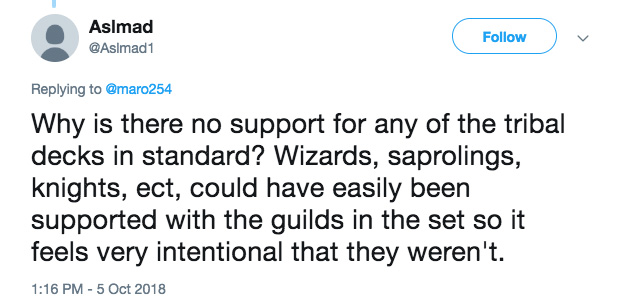
The biggest way a set supports tribal themes of previous sets is by having creatures of that tribe. For example, there are twelve Wizards in the set, all but two of which are only blue and/or red, the colors of the Wizard tribal cards in Dominaria. There are nine creature cards that are Knights and three cards that aren't Knights that make Knight creature tokens (all but two of which are all or partially white, the color of the powerful Knight tribal card). As I explain in the question above, Saprolings just match up poorly with undergrowth (and others like Pirates and Dinosaurs are trickier to fit in creatively).
This leads to the next question, why doesn't the set have more cards that mechanically care about specific tribes? The answer is that it's a poor fit for how Ravnica uses creature types. You see, some worlds are narrow in their creature type usage (worlds like Innistrad where a majority of creatures fall within a small band of creature types) and some worlds are broad (worlds such as Ravnica where there is a wide breadth of different creature types). Narrow worlds are important because they support tribal decks in smaller formats like Standard. Broad worlds are important because they support tribal decks in larger formats where players can build around creature types that show up less frequently.
Broad sets tend to be a bad place to do too many mechanical tribal cards, because those cards have no function in Limited and usually are what we call "traps," where they lead a drafter astray chasing a theme that's never going to show up. Usually when we make tribal cards in a broad set, we put them at rare or mythic rare and use designs where the card has some function even if not surrounded by lots of the named creature type. What this means is Guilds of Ravnica is aiding tribal decks in the best way it can by being a repository of cards of many different tribes. It's just not a set well suited for mechanical tribal cards.
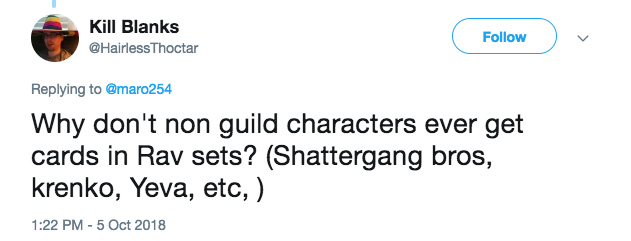
It's mostly a space issue. We only get so many legendary creatures per set, and sets tend to use their allotment to play up the set's major theme(s), which for Ravnica is the guilds. Because we have other avenues, things like supplemental sets, to pick up the non-guild Ravnica legendary characters, we tend to do them there rather than in the sets themselves.

The former. Selesnya's theme is creatures, which is one of the deeper guild themes mechanically. For example, Selesnya could have a mechanic that cares about creatures, affects creatures, uses creatures as a resource, or even a mechanic that just goes on creatures. There's a lot of meat on that bone. Convoke was chosen for a return because of how perfectly it blended in with everything else going on in the set, not because there wasn't anything else that could be done.

Commander is a popular format, so we spend a lot of time thinking about it. We're also aware that red and white are the two colors that have the most issues in Commander based on how the colors are crafted for two-player play. When we see opportunities to help with either color in Commander, we'll often take them. (And behind the scenes, we're doing work to expand what the colors can do in Commander while staying true to the color pie.) Here's the problem. There are a lot of players that play Magic in formats other than Commander, and we're also making cards for them. In addition, we want the legendary Boros creatures to feel like Boros and the guild is very focused on combat, much as the Golgari is focused on the graveyard or Izzet is focused on instants and sorceries.
Mentor is a cool new mechanic, and if we wanted to make sweet legendary creatures that interact with it, this is the only set we can do that with. There are many different outlets for us to make red-white cards for Commander, but only one (within this period of time) to make Boros creatures. Note we did put a cool ability on Tajic which protects your creatures from outside of combat. This can be used in other ways than just an aggressive attack deck. Aurelia's bonus, likewise, can also be used in a more control strategy to boost your one (or two, she does have mentor) attacking creature.
It's very easy when you care about a specific thing to view any new set in that light. "This new set clearly could have done [Thing A] which would have been good for the way I play Magic." R&D doesn't have the luxury of just maximizing the game for one format, so we have to pick and choose where we apply our resources. Long term, we're working to produce more red-white commanders that are less combat focused, it's just hard to do that in Boros whose whole identity is built around being combat focused.

Let me end today with a popular question I've gotten: who's this guy?
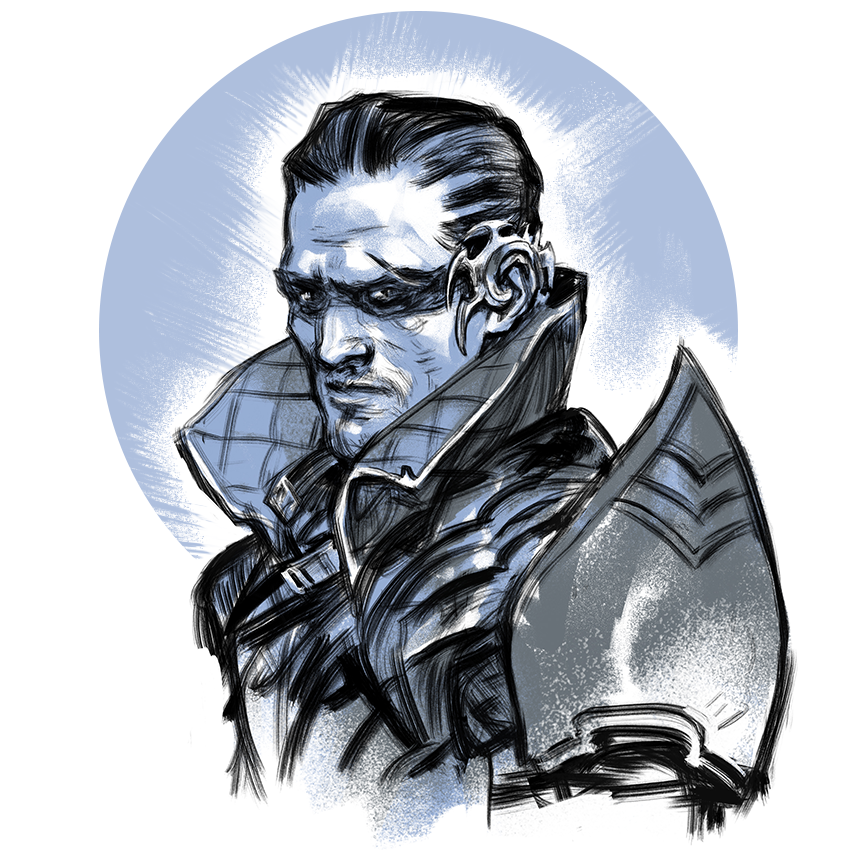
He doesn't appear on any cards, yet he's on the booster pack and the Prerelease box and in some ads. Who is he?
I have two different answers, and you can pick the one that satisfies you the most.
Answer #1 – The Guilds of Ravnica graphic design team (the group that decides the look and feel of all of the product and marketing for the set) wanted to have an image for each guild. The image was going to be used in various places, including the booster pack, the Prerelease box, and marketing. To get exactly what they needed, they commissioned art for these five images.
The big question was what character should each guild use? Izzet and Golgari were pretty easy choices as each had a Planeswalker (Ral and Vraska, respectively). Next, the team looked at the legendary creatures in the set. Aurelia was a good choice for Boros and Emmara was a good choice for Selesnya. Neither Etrata or Lazav quite matched their needs for Dimir, so they ended up choosing to make a new character. Remember, that this happened before the other art had been commissioned, so there weren't an endless number of creatures they had visual designs to choose from.
I'm not sure if they looked for a place to use that new character on a card, but odds are the timing didn't allow them to have the finished illustration in time to use it as a reference for other art (remember, none of the packing images is directly used on cards). And that is why there's a Dimir character you don't know on the packaging.
Answer #2 – It's Lazav. He's a shapeshifter, so we picked a picture of him in disguise as a random Dimir member.
Hopefully, one of these two answers will bring some peace to the many who have asked this question.
Tweet Nothings
That's all the time we have for today. I hope you enjoyed all my answers. As always, if you have any feedback about today's column, about anything I said or about Guilds of Ravnica itself, you can email me or contact me through any of my social media accounts (Twitter, Tumblr, Google+, and Instagram).
Join me next week when I introduce a new scale (well, new to this column anyway).
Until then, may you play enough Guilds of Ravnica that you come up with even more questions to ask me.
#585: Magic Evolution, Part 6
#585: Magic Evolution, Part 6
This is another in my "Magic Evolution" series, where I go through the history of the game and talk about the design innovations each set brought to the table. In this podcast, I talk about Champions of Kamigawa block.
#586: Flickering
#586: Flickering
31:45
This podcast is all about an unnamed but commonly used mechanic, one where you exile a permanent and then return it to the battlefield. R&D calls this ability "flickering" (it's also known as "blinking"), and this podcast will talk about its...
- Episode 584 Alpha Playtesters
- Episode 583 Lessons Learned – Ixalan
- Episode 582 Creature Types

